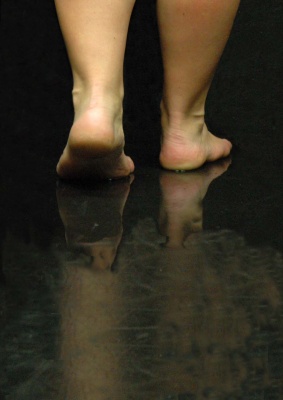THE WATER STATION
Studio 77, Victoria University, 77 Fairlie Tce, Kelburn, Wellington
14/05/2013 - 18/05/2013
Production Details
Victoria University Theatre students undergo rigorous performance training for New Zealand premiere of Japanese tour-de-force.
Wellington is fast becoming New Zealand’s centre of Kiwi-produced Asian-infused theatre, with Victoria University’s Theatre Programme at the heart of it. Each year under the direction of Dr Megan Evans, expert in Asian performance practices and director of the recent Madam X and Mister Q (NZ Fringe 2013 Best Theatre), third year Theatre students undergo rigorous performance training in a variety of Asian theatre techniques, which results in outstanding works of theatre.
Always highly-acclaimed sell-out shows, these have ranged from adaptations of Chinese operas to Asian inspired Shakespeare re-creations, to this year’s May production, The Water Station, a language-less poetic work by acclaimed Japanese playwright Ōta Shōgo.
In The Water Station, language is removed and action slowed. Time is brought crashing down to the soundtrack of a broken faucet. The ache of loss and loneliness, the anticipation of a journey, the ecstasy of love and lust, are all carried by the travellers who pass by and refresh themselves at a water station. “The interaction between water and the human body has a primal reverence rooted at the core of our being. Not just to quench thirst, it is also the absorption of life, death, and a purification of the soul” says student Simon Haren.
Since its premiere in 1981, international audiences have been captivated by this breath-taking exploration of human need and belonging, and now Wellington audiences have the chance to experience it. It will be, however, a different experience for fans of Evans’ work. She says, “in the previous Asian-infused productions I have directed at Victoria (most recently Madam X and Mister Q and Big Love), performance conventions were on display. For this production students are studying Ōta Shōgo’s ‘Transformation Theatre,’ which means rigorous training to temper the internal energies demanded by Ōta’s style.” Hard work, but the payoff promises to be spectacular.
The Water Station runs from Tuesday 14th to 18th of May, at Victoria University’s Studio 77, and promises to be a unique theatrical experience on the Wellington arts calendar.
What: The Water Station, by Ōta Shōgo, directed by Dr. Megan Evans. Designed and performed by THEA323 Intercultural Performance Practices students
When: Tuesday 14 – Saturday 18 May, 7.30pm
Where: Studio 77, 77 Fairlie Terrace
Bookings: theatre@vuw.ac.nz
Tickets: $15 full / $8 concession. Pay by cash only on the door.
Visit our Facebook page
Theatre ,
Beautiful, disciplined, focused, committed
Review by Phoebe Smith 16th May 2013
Mari Boyd’s translation of Ōta Shōgo’s The Water Station ‘script as document’, as adapted by the THEA 323 students and director Megan Evans, is a compelling and unusual theatrical experience. Here we experience wordless, avant-garde theatre, its creation deeply rooted in Japanese Nō and Chinese Xiqu.
Immediately we are struck by atmospheric beauty. Studio 77 has become an oasis on a pathway to somewhere. Down-stage we have a small, square pool, with a constant trickle of drips from above rippling its surface. Upstage a hillock of shoes is piled alongside a ramp that leads up, past a magical-dump (think The Labyrinth after Sarah eats the peach, post ball-room, on a smaller scale) and continues onto a pathway to, well, somewhere. Above, empty plastic bottles are suspended like light bulbs or objects of desire or – what they actually make me think of, anyone who wants to go with me on this one: the individual gene-bank DNA capsules from Ken Catran’s Deepwater Black series.
Slowly, ever so slowly, characters enter the space. This tempo (according to the programme notes, “faster than Ota’s prescribed 2 metres in 5 minutes”) is at times utterly effective and hypnotic and at times mildly infuriating. The times when actors manage to seemingly move all of their muscles exactly as they would at an everyday tempo but all slowed down to some degree, are truly magical.
We’ve all had a well-earned drink at some point in our lives, as testified by the collective sigh when finally a character reaches the inexorable drips and drinks. And here begins an exploration of the sum of our relationship with water. Water as our life-force.
The play appears to represent a cycle of life and death – a universal journey rather than an example of cause and effect. Almost every character enters from the same point, then exits off down the path after having an encounter with the ‘water station.’ Quite apart from anything else, watching people interact with water is beautiful.
The choreography of this piece is largely excellent, though occasionally it feels as though one is watching an audition for The Silent Scream. While the tempo is a huge part of what makes this worth seeing, it also raises a question about pace and the pros and cons of variety.
In this piece the one significant change of tempo comes in the form of Emma Luxton’s ‘Woman with a Parasol.’ The effect is confusing. I wonder if her staccato movements are representative of machine gun fire (as we just met some soldiers) or perhaps rain (water on the brain, plus parasol). Maybe errantly, I search for meaning in this alteration in pace, but don’t find any.
I do recommend you go and see this. It is beautiful and it shows high levels of discipline, focus and commitment. Wee first.
Copyright © in the review belongs to the reviewer





Comments